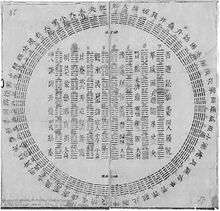Hexagram (I Ching)

The I Ching book consists of 64 hexagrams.[2] [3] A hexagram is a figure composed of six stacked horizontal lines (爻 yáo), where each line is either Yang (an unbroken, or solid line), or Yin (broken, an open line with a gap in the center). The hexagram lines are traditionally counted from the bottom up, so the lowest line is considered line one while the top line is line six. Hexagrams are formed by combining the original eight trigrams in different combinations. Each hexagram is accompanied with a description, often cryptic, akin to parables. Each line in every hexagram is also given a similar description.
The Chinese word for a hexagram is 卦 "gua", although that also means trigram.
Types

Classic and modern I Ching commentaries mention a number of different hexagram types:
- Eight trigrams
- Original hexagram
- Future hexagram
- Nuclear hexagram
- Reverse hexagram (is found by turning a hexagram upside down)
- Complementary hexagram (is found by changing all the lines into their opposite)
- Hexagram of Change (bian gua)
- Internal Hexagram (nei gua)
- External Hexagram (wai gua)
- Mutual Hexagram (hu gua)
Sequences
The most commonly known sequence is the King Wen sequence. A totally different sequence was found in the Mawangdui Silk Texts. The hexagrams are also found in the Binary sequence, also known as Fu Xi sequence or Shao Yong sequence.